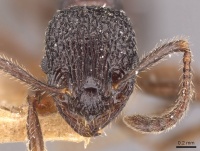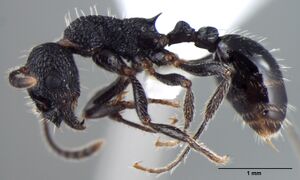Myrmica rupestris
| Myrmica rupestris | |
|---|---|

| |
| Scientific classification | |
| Kingdom: | Animalia |
| Phylum: | Arthropoda |
| Class: | Insecta |
| Order: | Hymenoptera |
| Family: | Formicidae |
| Subfamily: | Myrmicinae |
| Tribe: | Myrmicini |
| Genus: | Myrmica |
| Species: | M. rupestris |
| Binomial name | |
| Myrmica rupestris Forel, 1902 | |
| Synonyms | |
| |
M. rupestris has been collected at relatively higher altitudes than Myrmica rugosa, between 2100 and 4100 m. Nests are built in soil, often under stones, in open deciduous and mixed forests, and places with steppe-like vegetation (Philip Ward, pers. comm.). Like M. rugosa, queens and males have been found in nests of M. rupestris from the end of May to the end of June, much earlier than in Euro-Siberian species. This species is host to the social parasite Myrmica nefaria. (Radchenko and Elmes, 2010; Bharti, 2012)
In the Northwest Himalaya, the species was collected under the stones in subtemperate forests of scattered Cedrus, oak and some broad-leaved trees. Few collection sites were under intense anthropogenic activities, surrounded by apple orchards. The mean temperature and humidity recorded at the nest was 31°C and 63% respectively. The temperature ranges in summer (March to June) from 8°C to 36°C and during winter (November to February) from 3°C to 27°C. In Northeast Himalaya, nests were observed under stone in grasslands and on ground covered with dense vegetation, mostly in wet soil. Nesting sites had an average temperature of 15°C and relative humidity of 85%. Alates were collected during the months of June to early August in Northwest Himalaya, and in September to October in Northeast Himalaya. Altitudinal range of this species varies from 1341m at the Ekra peak to 4084m in Central Himalaya. (Bharti et al., 2016)
Identification
Radchenko and Elmes (2010) - A member of the rugosa complex of the rugosa species group. It differs from most other members of this group, Myrmica rugosa, Myrmica aimonissabaudiae and Myrmica hecate, by the much coarser sculpture on its petiole and postpetiole; M. rupestris most resembles Myrmica foreliana, from which it differs by the lack of punctations on the surface of the head and alitrunk between rugae.
Keys including this Species
Distribution
India, Nepal, Bhutan, NE Afghanistan.
Latitudinal Distribution Pattern
Latitudinal Range: 39.03333333° to 27.299791°.
| North Temperate |
North Subtropical |
Tropical | South Subtropical |
South Temperate |
- Source: AntMaps
Distribution based on Regional Taxon Lists
Oriental Region: Bhutan, India (type locality), Nepal.
Palaearctic Region: Afghanistan, China.
Distribution based on AntMaps
Distribution based on AntWeb specimens
Check data from AntWeb
Countries Occupied
| Number of countries occupied by this species based on AntWiki Regional Taxon Lists. In general, fewer countries occupied indicates a narrower range, while more countries indicates a more widespread species. |

|
Estimated Abundance
| Relative abundance based on number of AntMaps records per species (this species within the purple bar). Fewer records (to the left) indicates a less abundant/encountered species while more records (to the right) indicates more abundant/encountered species. |

|
Biology
Castes
Worker
  
| |
| . | |
Nomenclature
The following information is derived from Barry Bolton's Online Catalogue of the Ants of the World.
- debilior. Myrmica rugosa var. debilior Forel, 1902c: 228 (w.) INDIA. Senior synonym of rugososmythiesi: Forel, 1902c: 228. Junior synonym of rupestris: Radchenko & Elmes, 2001a: 245.
- rugososmythiesi. Myrmica rugosa var. rugososmythiesi Forel, 1902c: 228 (w.) INDIA. Junior synonym of debilior: Forel, 1902c: 228.
- rupestris. Myrmica smythiesii var. rupestris Forel, 1902c: 227 (w.) INDIA. Radchenko & Elmes, 2002: 44 (q.m.). Raised to species and senior synonym of debilior (and its junior synonym rugososmythiesi), everesti : Radchenko & Elmes, 2001a: 245. See also: Radchenko & Elmes, 2010: 246.
- everesti. Myrmica everesti Donisthorpe, 1929a: 445 (w.) TIBET. Junior synonym of rupestris: Radchenko & Elmes, 2001a: 245.
Type Material
Myrmica rupestris
- Lectotype (designated by Radchenko & Elmes, 2001), worker (upper specimen on the pin with 3 workers), “N-W Himalaya, Ekra Peak, 4400 ft (Smythies)”, “LXXXIX/12, M. smythiesii For. v. rupestris For., Typus” (MHNG).
- Paralectotypes: 2 workers on the same pin as lectotype (MHNG); 1 worker, “w M. Smythiesii For. var. rupestris Forel, Ekra Peak Himalaya” (MSNG).
Myrmica rugosa debilior
- Lectotype (designated by Radchenko & Elmes, 2001), (upper specimen on the pin with 3 workers), “Himalaya (Smythies)”, “LIX/4, M. rugosa r. debilior” (MHNG).
- Paralectotypes (designated by Radchenko & Elmes, 2001): 2 workers on the same pin as lectotype (MHNG); 1 worker, with same labels as lectotype (UMO); 2 workers, “M. rugosoSmythiesii Forel w Himalaya Smythies, LX/4”, “var. debilior For.” (MSNG); 3 workers, “Himalaya (Smythies)”, “Forel coll.”, “M.C.Z. Cotype No. 556” (originally labelled as M. rugosa; for details see Radchenko & Elmes, 2001) (MCZ).
Myrmica everesti
- Holotype worker, “Himalaya, Jelap La, Tibetan side, 12,000 ft., l.iv.1924, Hingston” (BMNH).
- Paratypes: 2 workers (BMNH), 1 worker “Himalaya, Jelap La, Tibetan side, 12,000 ft., l.iv.1924, Hingston” (ZMMU).
Description
Etymology
Radchenko and Elmes (2010) - name from the Latin word rupes = rock with the adjectival suffix estris = origin or habit, probably to indicate that it was found under a rock or in a rocky place.
References
- Bharti, H. 2012. Myrmica nefaria sp.n. (Hymenoptera: Formicidae) – a new social parasite from Himalaya. Myrmecological News 16, 149-156.
- Bharti, H., Bharti, M., Kaur, P., Kaur, J. 2023. On the description of the larval stages of Myrmica inezae Forel, 1902 (Hymenoptera: Formicidae: Myrmicinae), an endemic Himalayan species, with notes on its natural history. Sociobiology 70(3), e9977 (doi:10.13102/sociobiology.v70i3.9977).
- Bharti, H., Kaur, P. Bharti, M. 2019. Description of the ant larvae of two species of the genus Myrmica Latreille, 1804 (Hymenoptera: Formicidae) from Indian Himalayas. Asian Myrmecology 11, e011004 (doi:10.20362/am.011004).
- Bharti, H., Sasi, S., Radchenko, A. 2016. Biogeography and ecology of Myrmica species (Formicidae: Myrmicinae) in Himalayan regions. Sociobiology 63, 956-975 (DOI 10.13102/sociobiology.v63i3.1145).
- de la Mora, A., Sankovitz, M., Purcell, J. 2020. Ants (Hymenoptera: Formicidae) as host and intruder: recent advances and future directions in the study of exploitative strategies. Myrmecological News 30: 53-71 (doi:10.25849/MYRMECOL.NEWS_030:053).
- Dendup, K.C., Dorji, C., Dhadwal, T., Bharti, H., Pfeiffer, M. 2021. A preliminary checklist of ants from Bhutan. Asian Myrmecology 14, e014005 (doi:10.20362/am.014005).
- Forel, A. 1902c. Myrmicinae nouveaux de l'Inde et de Ceylan. Rev. Suisse Zool. 10: 165-249 (page 227, worker described)
- Radchenko, A. G.; Elmes, G. W. 2002. First descriptions of the sexual forms of seven Himalayan Myrmica species (Hymenoptera, Formicidae). Vestn. Zool. 36(5): 35-46 (page 44, queen, male described)
- Radchenko, A. G.; Elmes, G.W. 2001b. A taxonomic revision of the ant genus Myrmica Latreille, 1804 from the Himalaya (Hymenoptera, Formicidae). Entomol. Basil. 23: 237-276 (page 245, Raised to species and senior synonym of debilior (and its junior synonym rugososmythiesi) and everesti )
- Radchenko, A.G. & Elmes, G.W. 2010. Myrmica ants of the Old World. Fauna Mundi 3: 1-789.
- Subedi, I.P., Budha, P.B., Bharti, H., Alonso, L. 2020. An updated checklist of Nepalese ants (Hymenoptera, Formicidae). ZooKeys 1006, 99–136 (doi:10.3897/zookeys.1006.58808).
References based on Global Ant Biodiversity Informatics
- Bharti H., S. Sasi, and A. Radchenko. 2016. Biogeography and ecology of Myrmica species (Formicidae: Myrmicinae) in Himalayan regions. Sociobiology 63(3): 956-975.
- Bharti H., Y. P. Sharma, M. Bharti, and M. Pfeiffer. 2013. Ant species richness, endemicity and functional groups, along an elevational gradient in the Himalayas. Asian Myrmecology 5: 79-101.
- Collingwood C.A. 1970. Formicidae (Hymenopter: Aculeata) of Nepal. Himalaya Khumbu Himal, 3: 371-388.
- Donisthorpe H. 1929. The Formicidae (Hymenoptera) taken by Major R. W. G. Hingston, M.C., I.M.S. (ret.), on the Mount Everest Expedition, 1924. Annals and Magazine of Natural History (10)4: 444-449.
- Forel A. 1902. Myrmicinae nouveaux de l'Inde et de Ceylan. Rev. Suisse Zool. 10: 165-249.
- Forel A. 1903. Les Formicides de l'Empire des Indes et de Ceylan. Part X. J. Bombay Nat. Hist. Soc. 14: 679-715.
- Guénard B., and R. R. Dunn. 2012. A checklist of the ants of China. Zootaxa 3558: 1-77.
- Jansen G., R. Savolainen, K. Vespalainen. 2010. Phylogeny, divergence-time estimation, biogeography and social parasite–host relationships of the Holarctic ant genusMyrmica(Hymenoptera: Formicidae). Molecular Phylogenetics and Evolution 56: 294-304.
- Radchenko A. G., and G. W. Elmes. 2001. A taxonomic revision of the ant genus Myrmica Latreille, 1804 from the Himalaya (Hymenoptera, Formicidae). Entomologica Basiliensia 23: 237-276.
- Radchenko A. G., and G. W. Elmes. 2002. First descriptions of the sexual forms of seven Himalayan Myrmica species (Hymenoptera, Formicidae). Vestnik Zoologii 36(5): 35-46.
- Radchenko, A. G., and G. W. Elmes. "A taxonomic revision of the ant genus Myrmica Latreille, 1804 from the Himalaya (Hymenoptera: Formicidae)." Entomologica Basiliensia 23 (2001): 237-276.
- Thapa V. K. 2000. An Inventory of Nepal's Insects, Vol. III. IUCN Nepal, Kathmandu, xi + 475 pp.
- Weber N. A. 1950. A revision of the North American ants of the genus Myrmica Latreille with a synopsis of the Palearctic species. III. Annals of the Entomological Society of America 43: 189-226.

